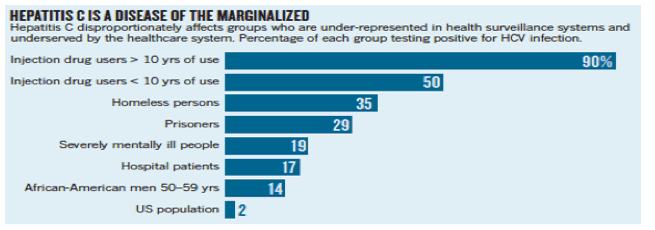| |
HCV Treatment & Barriers To Care in HIV/HCV-Coinfected
|
| |
| |
Jules Levin, NATAP
reimbursements issues medicaid, medicare, ADAP, private.
Barriers to care in HCV/HIV coinfected-
Drug use, not being engaged in care, psych issues, housing issues, not being undetectable on ART, HIV ART adherence, adherence concerns, being African-American, clinicians being willing to treat patients, patient desire to be treated, re-infection concerns sexually & IDU, drug-interactions/ART-DDIs, these have all been identified in the 2 Chicago studies & they are barriers all over, so how serious once the new regimens come out!!!
IAC: TURQUOISE-I: SAFETY AND EFFICACY OF ABT-450/R/OMBITASVIR, DASABUVIR, AND RIBAVIRIN IN PATIENTS CO-INFECTED WITH HEPATITIS C AND HIV-1 (07/21/14)
EASL/2014: USE OF SOFOSBUVIR/LEDIPASVIR FIXED DOSE COMBINATION FOR TREATMENT OF HCV GENOTYPE-1 INFECTION IN PATIENTS COINFECTED WITH HIV (Interim results)......http://www.natap.org/2014/EASL/EASL_05.htm
IAC: All-Oral Therapy with Sofosbuvir Plus Ribavirin for the Treatment of HCV Genotype 1, 2,3 and 4 Infection in Patients Coinfected with HIV (PHOTON-2) (07/21/14)
-----------------------
CROI/2014: The CORE HCV Cascade a Decade Later: Looking Ahead to an IFN-free Era - (03/24/14)
CROI/2014: The Hepatitis C Cascade of Care Among HIV Infected Patients Following Diagnosis of HCV Infection - (03/24/14)
CROI;/1024: Liver-related death among HIV/HCV coinfected individuals, implications for the era of directly acting antivirals - (03/24/14)......LRD (liver-related death) accounted for 27% of all deaths in HIV/HCV coinfected patients in EuroSIDA, on par with AIDS as the leading cause of death
CROI/2014: Level of Alcohol Use and Advanced Hepatic Fibrosis in HIV-Infected and Uninfected Patients...."there may be no safe level of alcohol use among HIV+ & HCV+" - (03/24/14)
IDSA/2013: Barriers to Hepatitis C Treatment in an HIV-HCV Co- Infected Cohort - (10/07/13)......Northwestern University Feinberg School of Medicine, Chicago, IL, USA......."In univariate analysis, female gender, African American ethnicity and active substance appear to be predictors of failure to treat. AIDS (CD4 + T cells < 200 cells/ml), NNRTI containing antiretroviral regimens and history of heavy alcohol use were also appear to be significant. Major barriers to therapy were failure to complete hepatology evaluation and deferral of therapy until new agents are available for those patients who area considered appropriate candidates for HCV therapy......
IDSA: HIV/Hepatitis C (HCV) Co-infection among Men who have Sex with Men (MSM) in New York City (NYC), 2000-2010 - Increased from 7% to 24% - (10/10/13)
HCV in HIV+ MSM in SF: "Epidemiology of the Viral Hepatitis-HIV Syndemic in San Francisco: A Collaborative Surveillance Approach" - (12/27/13)
[HCV Heterogeneity among various Latino groups] Prevalence of Hepatitis C Virus Infection in US Hispanic/Latino Adults: Results from the NHANES 2007-2010 and HCHS/SOL Studies - (01/14/14)
......During 2008-2011 Hispanic/Latino adults from 4 US communities (Bronx, Miami, Chicago, and San Diego) were recruited to participate in the Hispanic Community Health Study/Study of Latinos (HCHS/SOL)......men and women of Puerto Rican background in the Bronx had the highest HCV prevalence (14.2% and 4.1%......A recent study of 9579 patients receiving care at Bronx primary care clinics estimated HCV prevalence to be 4.6%-7.7% [8]. These patients were predominantly women (72%) and minority (51% Hispanic/Latino, 32% non-Hispanic/non-Latino Black), with a mean age of 49 years [8]. In subgroup analysis of this population, HCV prevalence was 14.8% among 1334 Hispanic/Latino men and 5.5% among 3581 Hispanic/Latino women (William Southern, personal communication). A similar study of 1000 primary care patients in a neighborhood adjacent to the Bronx found that 8.3% were HCV seropositive [9]."
HIV/HCV Coinfection -Psych/Social Issues, Screening for HCC, Pathogenesis of Accelerated Fibrogenesis, excerpts from meeting - (12/27/13)
Although we see significant advances in our understanding of the pathophysiology of liver disease in those with HIV infection and major strides in the development of new medications to treat hepatitis C, significant issues related to poverty, health care access, concomitant psychiatric disorders, and substance abuse remain as barriers to improved health.......Psychiatric diagnoses are common among those with HIV- and liver-related coinfections. At Johns Hopkins, 54% of patients presenting for medical evaluation had an Axis 1 psychiatric diagnosis, including major depression (20%), adjustment disorder (18%), cognitive impairment (18%), and substance abuse (74%). The presence of untreated mental disorders has a significant effect on the probability of overall survival.[62].....In substance-abuse cohorts, traditional medical models that depend upon diagnosis linkage to treatment with subsequent improvement in prognosis may not apply. Veterans with psychiatric disorders are less likely to be offered HCV treatment.[54] Among injection drug users (IDUs) with HCV, treatment uptake rates ranging from 1.1% to 4% have been reported.[55, 56] Reasons for this are clearly multifactoral, but include bias by providers against treatment of IDUs,[57] lack of health care funding for disease management and treatment of the uninsured, and an overall lack of providers able to provide care.
Barriers to HCV Screening/Care among IDUs: "Perceptions of drug users regarding Hepatitis C screening and care: a qualitative study" - (12/27/13)

IAC: Does the Addition of HCV Testing to a Rapid HIV Testing Program Impact HIV Test Acceptance? A Randomized Controlled Trial - (08/04/14)
Pilot Program Integrating HCV Screening Into HIV Screening in Incarcerated in Massachusetts: 37.8% (n=531) had an HCV-related test result reported to MAVEN after release, indicating linkage to care - (12/27/13)
|
|
| |
| |
|
|
|